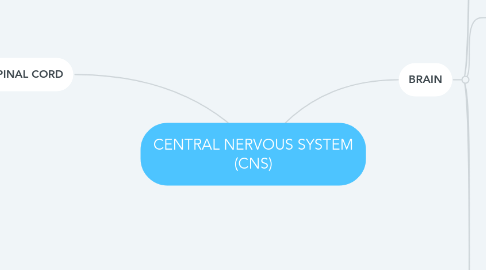
1. SPINAL CORD
1.1. Midbrain
1.1.1. Involved with:
1.1.1.1. Fight responce
1.1.1.2. Flight responce
1.1.1.3. Freeze response
1.1.2. Cerebral prednucles
1.1.2.1. Connects:
1.1.2.1.1. Midbrain to cerebral cortex
1.1.2.2. Motor signals:
1.1.2.2.1. From cerebrum to midbrain
1.1.2.3. Corpora quadrigemina
1.1.2.3.1. Made up of two things
1.2. Pons
1.2.1. Pyramidal tracts
1.2.1.1. Motor tracts
1.2.1.1.1. Runs through entire spinal cord
1.3. Reticular Formation Nuclei
1.3.1. Found in brain stem
1.3.2. Involved in:
1.3.2.1. Controlling autonomic behavior
1.4. Medulla Oblongata
1.4.1. Collection of gray matter
1.4.1.1. Reticular formation
1.4.2. Controls vital functions
1.4.2.1. Regulated by:
1.4.2.1.1. Autonomic nervous system
1.4.3. Cardio center
1.4.3.1. Heart rate
1.4.3.2. Strength of heart beat
1.4.4. Vascular center
1.4.4.1. Dilation/ constriction of:
1.4.4.1.1. Blood vessels
1.4.5. Respiration center
1.4.5.1. Respiratory rate
1.4.6. Pyramids
1.4.6.1. Motor tracts
1.4.6.1.1. Run through entire spinal cord
1.5. Anterior Roots
1.5.1. Contains:
1.5.1.1. Viseral motor neuron cell bodies
1.5.1.2. Somatic motor neuron cell bodies
1.5.2. The axons from the neurons
1.5.2.1. Extend out from the root
1.5.3. All signals are output
1.6. Posterior Roots
1.6.1. Unipolar
1.7. Posterior Root Ganglion
1.7.1. In buldge
1.7.1.1. With posterior root
1.8. Ascending Tracts
1.8.1. Sensory signals
1.8.1.1. Going towards the brain
1.9. Descending Tracts
1.9.1. Major motor tracts
2. BRAIN
2.1. Blood Brain Barrier
2.1.1. Blood vessels
2.1.2. Capillary
2.1.3. Simple squamous epithelium
2.1.4. Endothelium
2.1.5. Abundant tight junctions
2.1.6. Separation of:
2.1.6.1. Circulating blood
2.1.6.2. Brain extra cellular fluid
2.1.6.2.1. CSF in the CNS
2.1.7. Occurs along all capillaries
2.1.7.1. Consists of tight junctions
2.1.7.1.1. Around capillaries
2.1.8. Significance:
2.1.8.1. Keeps harmful substances out of brain
2.1.8.1.1. Bacteria
2.1.8.1.2. Viruses
2.1.8.1.3. Toxins
2.2. Cerebellum
2.2.1. Behind brainstem
2.2.2. Smooths body movement
2.2.3. Coordinates body movements
2.2.4. Maintains posture and equilibrium
2.2.5. Recieves:
2.2.5.1. Propriocepture signals
2.2.5.2. Mechano receptor signals
2.3. Cerebrum
2.3.1. Commissural tracts
2.3.1.1. Allow right and left hemispheres to communicate
2.3.2. Association tracts
2.3.2.1. Single side of hemisphere communication
2.3.3. Projection tracts
2.3.3.1. Longest
2.3.3.2. Ascending and descending tracts
2.3.3.2.1. Ascending - sensory
2.3.3.2.2. Descending - motor
2.3.3.3. Connects:
2.3.3.3.1. Cerebral cortex to thalamus
2.3.3.3.2. Brain stem to spinal cord
2.3.3.3.3. And beyond
2.3.4. Frontal (lobe)
2.3.4.1. Voluntary movement
2.3.4.2. Prefrontal cortex
2.3.4.2.1. Outer layer
2.3.4.2.2. Processing
2.3.4.2.3. Planning
2.3.4.2.4. Decision making
2.3.4.2.5. Task management
2.3.4.2.6. Memory
2.3.4.2.7. Problem solving
2.3.5. Parietal (lobe)
2.3.5.1. Sensory stimuli
2.3.6. Temporal (lobe)
2.3.6.1. Auditory and olfactory cortex
2.3.6.1.1. Receives information
2.3.6.2. Recognizes objects
2.3.6.2.1. Written words
2.3.6.2.2. Faces
2.3.6.2.3. Emotional responces
2.3.6.2.4. Memory
2.3.6.3. Limbic system
2.3.6.3.1. Emotions
2.3.7. Occipital (lobe)
2.3.7.1. Visual cortex
2.3.7.1.1. Sight
2.3.8. Insula
2.3.8.1. Deep
2.3.8.1.1. Within lateral sulcus
2.3.8.2. Gustatory cortex
2.3.8.2.1. Taste
2.3.8.3. General visceral sensations
2.3.8.3.1. Are processed
2.4. Precentral Gyrus
2.4.1. Anterior to central sulcus
2.4.2. Primary motor cortex
2.4.2.1. Where movement is initiated
2.4.3. Motor signal
2.4.3.1. Messages sent out
2.5. Postcentral Gyrus
2.5.1. Posterior to central sulcus
2.5.2. Primary somatosensory cortex
2.5.2.1. Messages come here
2.5.3. Things that are felt in general senses
2.5.3.1. All those receptors
2.5.3.2. Proprioceptors
2.5.3.2.1. Strech
2.5.4. Sensory signals
2.5.4.1. Messages come here
2.6. Diencephalon
2.6.1. Has three parts:
2.6.1.1. Thalamus
2.6.1.1.1. Relay station
2.6.1.1.2. Several nuclei
2.6.1.1.3. Information traveling to cerebral cortex
2.6.1.1.4. Amplifies (turns up)
2.6.1.1.5. Dampen (turns down)
2.6.1.2. Hypothalamus
2.6.1.2.1. Just below thalamus
2.6.1.2.2. Control/ Regulation of:
2.6.1.2.3. Involved with:
2.6.1.3. Epithalamus
2.6.1.3.1. Pineal gland
